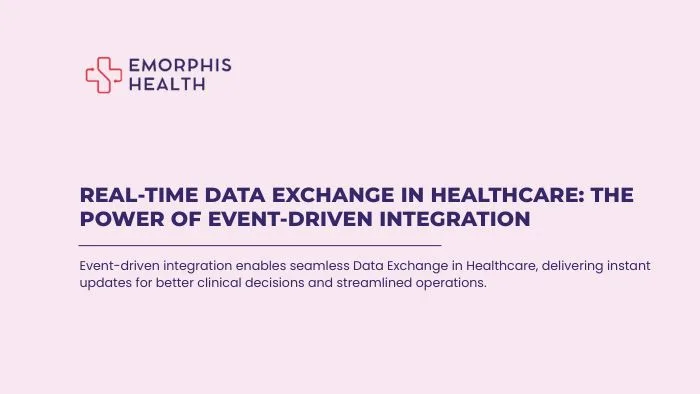Introduction
See Contents
Data Exchange in Healthcare is rapidly evolving, transforming the way patient information, clinical records, and operational data are shared across systems. Traditional methods of data sharing often rely on batch processing, which introduces delays and increases the risk of errors. In contrast, real-time data exchange ensures that critical information flows seamlessly between healthcare providers, improving decision-making, patient outcomes, and operational efficiency.
Event-driven integration is at the heart of this transformation. By responding to events as they occur, healthcare systems can exchange data instantaneously, ensuring that the right information reaches the right people at the right time.
Understanding Event-Driven Integration in Healthcare
Event-driven integration is a software architecture where systems communicate by producing and consuming events. An event is any change in state or occurrence that may be relevant to other systems, such as a new lab result, a medication update, or a patient admission.
In healthcare, event-driven integration enables different applications, devices, and platforms to stay synchronized without continuous polling or manual intervention. For example, when a patient’s vital signs are captured by a wearable device, the system can immediately trigger notifications to clinicians or update the electronic health record (EHR). This approach minimizes latency and ensures that healthcare providers have the most current data for informed decision-making.
Find details on why HL7 Integration still matters today.
Benefits of Real-Time Data Exchange in Healthcare
A. Enhanced Patient Care
Real-time data exchange ensures that healthcare providers have immediate access to the latest patient information. This reduces the risk of errors, avoids duplicate tests, and allows for timely interventions, which is critical in emergencies.
B. Operational Efficiency
Automated event-driven data exchange reduces the need for manual data entry and repetitive administrative tasks. Healthcare organizations can streamline workflows, optimize resource allocation, and reduce operational costs.
C. Improved Interoperability
Event-driven integration supports interoperability between disparate healthcare systems, including EHRs, laboratory systems, imaging platforms, and IoT devices. This creates a unified data ecosystem where different applications can communicate effectively.
D. Data Accuracy and Consistency
Real-time updates ensure that all stakeholders have access to the most accurate and consistent information. This reduces discrepancies between systems and improves the reliability of clinical and operational decisions.
E. Regulatory Compliance
Healthcare organizations must comply with regulations such as HIPAA, which require secure and accurate data handling. Event-driven integration supports secure data exchange and provides traceable records of all data transactions, helping organizations meet compliance requirements.
Key Use Cases of Event-Driven Data Exchange in Healthcare
1. Remote Patient Monitoring
Wearables and connected devices capture patient data continuously. Event-driven integration ensures that this data is sent in real-time to healthcare providers, enabling proactive interventions and personalized care. This allows early detection of anomalies and reduces hospital readmissions.
2. Clinical Decision Support Systems
EHRs integrated with real-time data streams allow clinicians to receive instant alerts and recommendations based on the latest patient information, supporting faster and more accurate clinical decisions. It also helps in monitoring treatment effectiveness and adjusting care plans dynamically.
3. Hospital Operations Management
Event-driven systems track bed availability, patient admissions, and staff allocation in real-time. This improves hospital efficiency and reduces delays in patient care. It also supports better coordination during emergencies and resource-intensive procedures.
4. Pharmacy and Medication Management
Pharmacies can automatically receive updates on prescription changes or refill requests. Real-time integration reduces errors, prevents stockouts, and ensures timely medication delivery. Integration with EHRs also allows pharmacists to flag potential drug interactions immediately.
5. Laboratory and Diagnostic Data Sharing
Lab results and diagnostic reports can be shared instantly with clinicians, reducing turnaround time. Event-driven integration ensures that critical test results trigger immediate alerts for urgent cases, enabling faster interventions and treatment adjustments.
6. Patient Engagement and Communication
Automated alerts, reminders, and notifications can be sent to patients in real-time. Event-driven systems enable appointment reminders, medication prompts, and personalized health advice, improving patient adherence and satisfaction.
7. Emergency Response and Telemedicine
Real-time data exchange supports telemedicine consultations by providing up-to-date patient records to remote clinicians. In emergencies, event-driven systems can notify care teams immediately, allowing quicker triage and response.
8. Medical Device Integration
Connected medical devices such as infusion pumps, ventilators, and imaging systems can transmit operational data in real-time. This helps healthcare teams monitor device performance, detect anomalies, and prevent malfunctions that could affect patient safety.
9. Population Health Management
Aggregated data from multiple sources can be analyzed in real-time to identify trends, track outbreaks, and manage public health initiatives. Event-driven integration allows public health authorities to respond proactively to emerging health issues.
10. Care Coordination Across Multiple Providers
Event-driven data exchange enables seamless sharing of patient information across specialists, primary care providers, and care teams. Real-time updates ensure that all providers have access to the latest medical history, test results, and treatment plans, reducing miscommunication and improving continuity of care.
With these diverse use cases demonstrating the impact of event-driven data exchange, it is equally important to understand the challenges healthcare organizations may face when implementing real-time integration.
Challenges in Implementing Real-Time Data Exchange
a. Data Security and Privacy
Handling sensitive healthcare data requires robust encryption and secure protocols. Event-driven systems must be designed to prevent unauthorized access and protect patient privacy.
b. System Compatibility
Healthcare organizations often operate multiple legacy systems. Integrating these systems with modern event-driven platforms requires careful planning and sometimes custom connectors.
c. Data Standardization
Different systems may use varied data formats. Real-time data exchange requires consistent data standards such as HL7 FHIR to ensure that information is accurately interpreted across platforms.
d. Scalability
As healthcare data grows exponentially, event-driven systems must be scalable to handle high volumes of events without compromising performance.
Future of Data Exchange in Healthcare
The future of Data Exchange in Healthcare lies in expanding event-driven integration to incorporate advanced technologies such as artificial intelligence, predictive analytics, and machine learning. Real-time data streams can feed AI-powered decision support tools, enabling predictive care, automated diagnostics, and personalized treatment plans.
Healthcare organizations will increasingly rely on cloud-based platforms to facilitate seamless data sharing across geographies and care networks. As interoperability standards improve and technology adoption increases, real-time data exchange will become a core requirement for modern healthcare delivery.
Conclusion
Data Exchange in Healthcare is evolving from periodic updates to continuous, real-time information flows through event-driven integration. This shift improves patient care, enhances operational efficiency, and ensures accurate and timely data for clinical and administrative decisions. By embracing real-time data exchange, healthcare organizations can create a connected, responsive, and intelligent ecosystem that meets the demands of modern healthcare.
Connecting with AI and healthcare software development services experts can help organizations implement robust event-driven integration strategies and unlock the full potential of real-time data exchange in healthcare.







